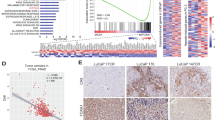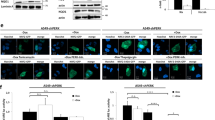Abstract
Hypoxic cancer cells are resistant to treatment, leading to the selection of cells with a more malignant phenotype. The expression of interleukin-8 (IL-8) plays an important role in the tumorigenesis and metastasis of solid tumors including prostate cancer. Recently, we detected elevated expression of IL-8 and IL-8 receptors in human prostate cancer tissue. The objective of the current study was to determine whether hypoxia increases IL-8 and IL-8 receptor expression in prostate cancer cells and whether this contributes to a survival advantage in hypoxic cells. IL-8, CXCR1 and CXCR2 messenger RNA (mRNA) expression in PC3 cells was upregulated in response to hypoxia in a time-dependent manner. Elevated IL-8 secretion following hypoxia was detected by enzyme-linked immunosorbent assay, while immunoblotting confirmed elevated receptor expression. Attenuation of hypoxia-inducible factor (HIF-1) and nuclear factor-κB (NF-κB) transcriptional activity using small interfering RNA (siRNA), a HIF-1 dominant-negative and pharmacological inhibitors, abrogated hypoxia-induced transcription of CXCR1 and CXCR2 in PC3 cells. Furthermore, chromatin-IP analysis demonstrated binding of HIF-1 and NF-κB to CXCR1. Finally, inhibition of IL-8 signaling potentiated etoposide-induced cell death in hypoxic PC3 cells. These results suggest that IL-8 signaling confers a survival advantage to hypoxic prostate cancer cells, and therefore, strategies to inhibit IL-8 signaling may sensitize hypoxic tumor cells to conventional treatments.
This is a preview of subscription content, access via your institution
Access options
Subscribe to this journal
Receive 50 print issues and online access
$259.00 per year
only $5.18 per issue
Buy this article
- Purchase on Springer Link
- Instant access to full article PDF
Prices may be subject to local taxes which are calculated during checkout






Similar content being viewed by others
References
Boland MP, Foster SJ, O’Neill LA . (1997). Daunorubicin activates NFkappaB and induces kappaB-dependent gene expression in HL-60 promyelocytic and Jurkat T-lymphoma cells. J Biol Chem 272: 12952–12960.
Brown LM, Cowen RL, Debray C, Eustace A, Erler JT, Sheppard FC et al. (2005). Reversing hypoxic cell chemoresistance in vitro using genetic and small molecule approaches targeting hypoxia inducible factor-1. Mol Pharmacol 69: 411–418.
Cairns RA, Hill RP . (2004). Acute hypoxia enhances spontaneous lymph node metastasis in an orthotopic murine model of human cervical carcinoma. Cancer Res 64: 2054–2061.
Cairns RA, Khokha R, Hill RP . (2003). Molecular mechanisms of tumor invasion and metastasis: an integrated view. Curr Mol Med 3: 659–671.
Carnell DM, Smith RE, Daley FM, Saunders MI, Bentzen SM, Hoskin PJ . (2006). An immunohistochemical assessment of hypoxia in prostate carcinoma using pimonidazole: implications for radioresistance. Int J Radiat Oncol Biol Phys 65: 91–99.
Coffey RNT, Morrissey C, Taylor CT, Fitzpatrick JM, Watson WG . (2005). Resistance to caspase-dependent, hypoxia-induced apoptosis is not hypoxia-inducible factor-1 alpha mediated in prostate carcinoma cells. Cancer 103: 1363–1374.
Cvetkovic D, Movsas B, Dicker AP, Hanlon AL, Greenberg RE, Chapman JD et al. (2001). Increased hypoxia correlates with increased expression of the angiogenesis marker vascular endothelial growth factor in human prostate cancer. Urology 57: 821–825.
Desbaillets I, Diserens AC, Tribolet N, Hamou MF, Van Meir EG . (1997). Upregulation of interleukin 8 by oxygen-deprived cells in glioblastoma suggests a role in leukocyte activation, chemotaxis, and angiogenesis. J Exp Med 186: 1201–1212.
Fernandez A, Udagawa T, Schwesinger C, Beecken W, Achilles-Gerte E, McDonnell T et al. (2001). Angiogenic potential of prostate carcinoma cells overexpressing bcl-2. J Natl Cancer Inst 93: 208–213.
Ghafar MA, Anastasiadis AG, Chen MW, Burchardt M, Olsson LE, Xie H et al. (2003). Acute hypoxia increases the aggressive characteristics and survival properties of prostate cancer cells. Prostate 54: 58–67.
Graeber TG, Peterson JF, Tsai M, Monica K, Fornace AJ, Giaccia AJ . (1994). Hypoxia induces accumulation of p53 protein, but activation of a G1-phase checkpoint by low-oxygen conditions is independent of p53 status. Mol Cell Biol 14: 6264–6277.
Grutkoski PS, Graeber CT, D'Amico R, Keeping H, Simms HH . (1999). Regulation of IL-8RA (CXCR1) expression in polymorphonuclear leukocytes by hypoxia/reoxygenation. J Leukoc Biol 65: 171–178.
Heidemann J, Ogawa H, Dwinell MB, Rafiee P, Maaser C, Gockel H et al. (2003). Angiogenic effects of interleukin 8 (CXCL8) in human intestinal microvascular endothelial cells are mediated by CXCR2. J Biol Chem 278: 8508–8515.
Hirota K, Semenza GL . (2006). Regulation of angiogenesis by hypoxia-inducible factor 1. Crit Rev Oncol Hematol 59: 15–26.
Inoue K, Slaton JW, Eve BY, Kim SJ, Perrotte P, Balbay MD et al. (2000a). Interleukin-8 expression regulates tumorigenicity and metastasis in androgen-independent prostate cancer. Clin Cancer Res 6: 2104–2119.
Inoue K, Slaton JW, Kim SJ, Perrotte P, Eve BY, Bar-Eli M et al. (2000b). Interleukin 8 expression regulates tumorigenicity and metastasis in human bladder cancer. Cancer Res 60: 2290–2299.
Kim KS, Rajagopal V, Gonsalves C, Johnson C, Kalra VK . (2006). A novel role of hypoxia-inducible factor in cobalt chloride- and hypoxia-mediated expression of IL-8 chemokine in human endothelial cells. J Immunol 177: 7211–7224.
Koong AC, Chen EY, Giaccia AJ . (1994). Hypoxia causes the activation of nuclear factor kappa B though the phosphorylation of I kappa B alpha on tyrosine residues. Cancer Res 54: 1425–1430.
Kunz M, Hartmann A, Flory E, Toksoy A, Koczan D, Thiesen HJ et al. (1999). Anoxia-induced up-regulation of interleukin-8 in human malignant melanoma. A potential mechanism for high tumor aggressiveness. Am J Pathol 155: 753–763.
Lee TH, Avraham H . (2002). Vascular endothelial growth factor modulates neutrophil transendothelial migration via up-regulation of interleukin-8 in human brain microvascular endothelial cells. J Biol Chem 277: 10445–10451.
Li A, Dubey S, Varney ML, Dave BJ, Singh RK . (2003). IL-8 directly enhanced endothelial cell survival, proliferation, and matrix metalloproteinases production and regulated angiogenesis. J Immunol 170: 3369–3376.
Li A, Varney ML, Valasek J, Godfrey M, Dave BJ, Singh RK . (2005). Autocrine role of interleukin-8 in induction of endothelial cell proliferation, survival, migration and MMP-2 production and angiogenesis. Angiogenesis 8: 63–71.
MacManus CF, Pettigrew J, Seaton A, Wilson C, Maxwell PJ, Berlingeri S et al. (2007). Interleukin-8 signaling promotes translational regulation of cyclin D in androgen-independent prostate cancer cells. Mol Cancer Res (in press).
Mizukami Y, Jo WS, Duerr EM, Gala M, Li J, Zhang X et al. (2005). Induction of interleukin-8 preserves the angiogenic response in HIF-1alpha-deficient colon cancer cells. Nat Med 11: 992–997.
Moldobaeva A, Wagner EM . (2005). Difference in proangiogenic potential of systemic and pulmonary endothelium: role of CXCR2. Am J Physiol Lung Cell Mol Physiol 288: L1117–L1123.
Moore BB, Arenberg DA, Stoy K, Morgan T, Addison CL, Morris SB et al. (1999). Distinct CXC chemokines mediate tumorigenicity of prostate cancer cells. Am J Pathol 154: 1503–1512.
Mosmann T . (1983). Rapid colorimetric assay for cellular growth and survival: application to proliferation and cytotoxicity assays. J Immunol Meth 65: 55–63.
Movsas B, Chapman JD, Horwitz EM, Pinover WH, Greenberg RE, Hanlon AL et al. (1999). Hypoxic regions exist in human prostate carcinoma. Urology 53: 11–18.
Murphy C, McGurk M, Pettigrew J, Santinelli A, Mazzucchelli R, Johnston PG et al. (2005). Nonapical and cytoplasmic expression of IL-8, CXCR1 and CXCR2 correlates with cell proliferation and microvessel density in prostate cancer. Clin Cancer Res 11: 4702–4711.
Schioppa T, Uranchimeg B, Saccani A, Biswas SK, Doni A, Rapisarda A et al. (2003). Regulation of the chemokine receptor CXCR4 by hypoxia. J Exp Med 198: 1391–1402.
Semenza GL, Wang GL . (1992). A nuclear factor induced by hypoxia via de novo protein synthesis binds to the human erythopoietin gene enhancer at a site required for transcriptional activation. Mol Cell Biol 12: 5447–5454.
Shi Q, Le X, Abbruzzese JL, Wang B, Mujaida N, Matsushima K et al. (1999). Cooperation between transcription factor AP-1 and NF-kappaB in the induction of interleukin-8 in human pancreatic adenocarcinoma cells by hypoxia. J Interferon Cytokine Res 19: 1363–1371.
Shi Q, Xiong Q, Le X, Xie K . (2001). Regulation of interleukin-8 expression by tumor associated stress factors. J Interferon Cytokine Res 21: 553–566.
Smith DR, Polverini PJ, Kunkel SL, Orringer MB, Whyte RI, Burdick MD et al. (1994). Inhibition of IL-8 attenuates angiogenesis in bronchogenic carcinoma. J Exp Med 179: 1409–1415.
Sowter HM, Raval RR, Moore JW, Ratcliffe PJ, Harris AL . (2003). Predominant role of hypoxia-inducible transcription factor (Hif)-1alpha versus Hif-2alpha in regulation of the transcriptional response to hypoxia. Cancer Res 63: 6130–6134.
Staller P, Sulitkova J, Lisztwan J, Moch H, Oakeley EJ, Krek W . (2003). Chemokine receptor CXCR4 downregulated by von Hippel–Lindau tumor suppressor pVHL. Nature 425: 307–311.
Subarsky P, Hill RP . (2003). The hypoxic tumor microenvironment and metastatic progression. Clin Exp Metastasis 20: 237–250.
Takaesu G, Surabhi RM, Park KJ, Ninomiya-Tsuji J, Matsumoto K, Gaynor RB . (2003). TAK1 is critical for IkappaB kinase-mediated activation of the NF-kappaB pathway. J Mol Biol 326: 105–115.
Takami M, Terry V, Petruzzelli L . (2002). Signaling pathways involved in IL-8-dependent activation of adhesion though Mac-1. J Immunol 168: 4559–4566.
Trisciuoglio D, Iervolino A, Zupi G, Del Bufalo D . (2005). Involvement of PI3K and MAPK signaling in bcl-2-induced vascular endothelial growth factor expression in melanoma cells. Mol Biol Cell 16: 4153–4162.
Vaupel P . (2004). The role of hypoxia-induced factors in tumor progression. Oncologist 9 (Suppl 4): 10–17.
Wingender E, Chen X, Hehl R, Karas H, Liebich I, Matys V et al. (2000). TRANSFAC: an integrated system for gene expression regulation. Nucleic Acids Res 28: 316–319.
Xu L, Pathak PS, Fukumura D . (2004). Hypoxia-induced activation of p38 mitogen-activated protein kinase and phosphatidylinositol-3-kinase signaling pathways contributes to expression of interleukin-8 in human ovarian carcinoma cells. Clin Cancer Res 10: 701–707.
Xu L, Xie K, Mukaida N, Matsushima K, Fidler IJ . (1999). Hypoxia-induced elevation in interleukin-8 expression by human ovarian carcinoma cells. Cancer Res 59: 5822–5829.
Yan SF, Lu J, Zou YS, Soh-Won J, Cohen DM, Buttrick PM et al. (1999). Hypoxia-associated induction of early growth response-1 gene expression. J Biol Chem 274: 15030–15040.
Yan SF, Zou YS, Mendelsohn M, Gao Y, Naka Y, Du Yan S et al. (1997). Nuclear factor interleukin 6 motifs mediate tissue-specific gene transcription in hypoxia. J Biol Chem 272: 4287–4294.
Yao KS, Xanthoudakis S, Curran T, O'Dwyer PJ . (1994). Activation of AP-1 and of a nuclear redox factor, Ref-1, in the response of HT29 colon cancer cells to hypoxia. Mol Cell Biol 14: 5997–6003.
Yasumoto K, Okamoto S, Mukaida N, Murakami S, Mai M, Matsushima K . (1992). Tumor necrosis factor alpha and interferon gamma synergistically induce interleukin 8 production in a human gastric cancer cell line though acting concurrently on AP-1 and NF-κB-like binding sites of the interleukin 8 gene. J Biol Chem 267: 22506–22511.
Yoneda J, Kuniyasu H, Crispens MA, Price JE, Bucana CD, Fidler IJ . (1998). Expression of angiogenesis-related genes and progression of human ovarian carcinomas in nude mice J. Natl Cancer Inst 90: 447–454.
Acknowledgements
This work was supported by research grants from the Ulster Cancer Foundation (PGJ and DJJW), the Northern Ireland HPSS R&D Office (RRG9.14 to DJJW) and The Wellcome Trust (067104/Z/02/Z to DJJW).
Author information
Authors and Affiliations
Corresponding author
Rights and permissions
About this article
Cite this article
Maxwell, P., Gallagher, R., Seaton, A. et al. HIF-1 and NF-κB-mediated upregulation of CXCR1 and CXCR2 expression promotes cell survival in hypoxic prostate cancer cells. Oncogene 26, 7333–7345 (2007). https://doi.org/10.1038/sj.onc.1210536
Received:
Revised:
Accepted:
Published:
Issue Date:
DOI: https://doi.org/10.1038/sj.onc.1210536
Keywords
This article is cited by
-
Hypoxia and TNF-α Synergistically Induce Expression of IL-6 and IL-8 in Human Fibroblast-like Synoviocytes via Enhancing TAK1/NF-κB/HIF-1α Signaling
Inflammation (2023)
-
The role of CXCL8 and CCNB1 in predicting hepatocellular carcinoma in the context of cirrhosis: implications for early detection and immune-based therapies
Journal of Cancer Research and Clinical Oncology (2023)
-
Targeting HIC1/TGF-β axis-shaped prostate cancer microenvironment restrains its progression
Cell Death & Disease (2022)
-
Phase I trial of HuMax-IL8 (BMS-986253), an anti-IL-8 monoclonal antibody, in patients with metastatic or unresectable solid tumors
Journal for ImmunoTherapy of Cancer (2019)
-
Chemokines in the cancer microenvironment and their relevance in cancer immunotherapy
Nature Reviews Immunology (2017)



